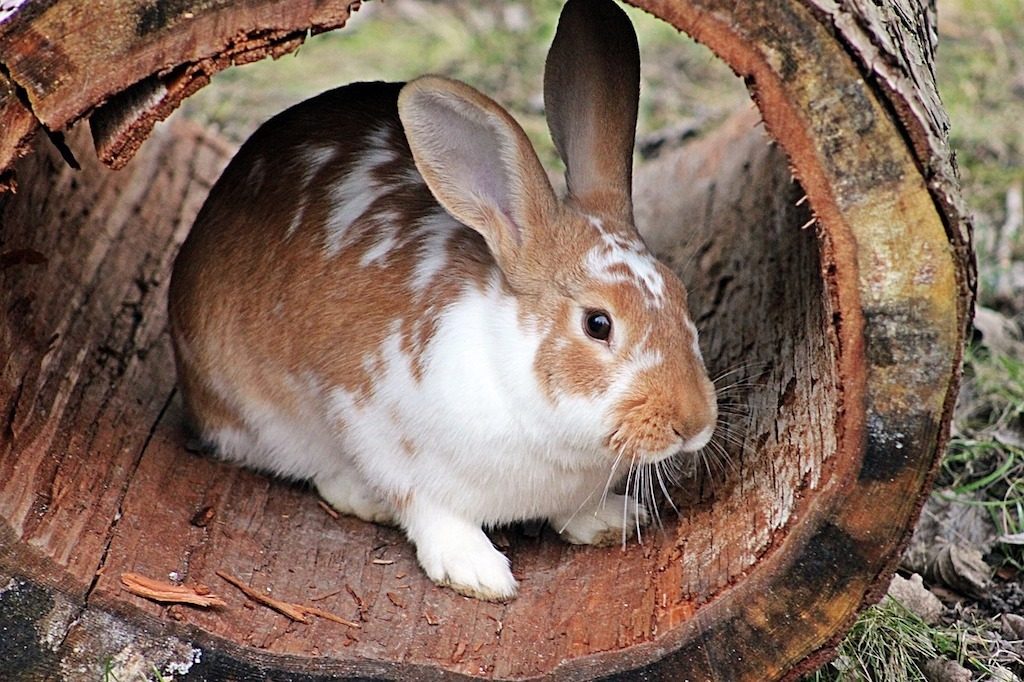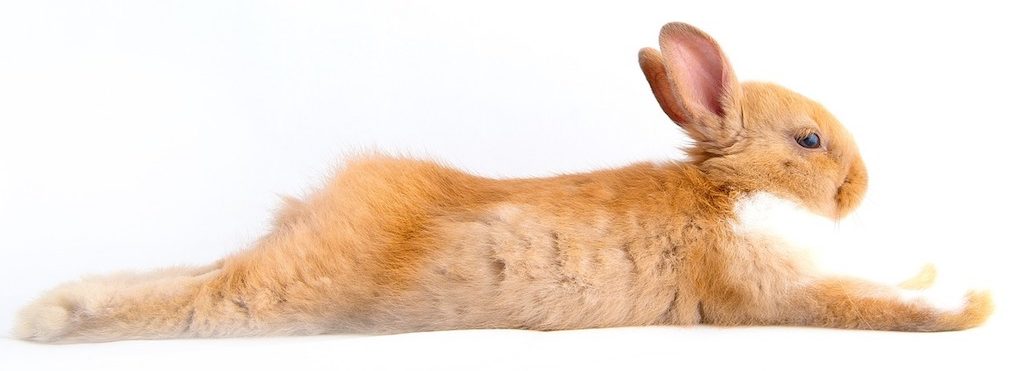Rabbits in the wild live in cozy burrows dug in soft earth, they lounge during the day in grassy fields or forest floors covered in leaves. This is the life that rabbit feet were designed for. Their claws were meant to dig into the ground to provide the traction to help them run, hop & dig. It can be hard to provide those conditions for pet rabbits. The unnatural cage flooring can cause a potentially serious condition known as “sore hocks”.
The medical term for sore hocks is ulcerative pododermatitis. If you keep chickens or ducks, you will recognize this term by it’s more common name in the poultry world, bumblefoot. The same bacterial infection & inflammation that can effect your bird’s feet, can also effect your rabbit friends. Similarly to bumblefoot in chickens, sore hocks in rabbits, if left untreated, can cause a potentially fatal staph infection.
Causes of sore hocks
- Improper flooring. Ideally, rabbits would be allowed to spend a good portion of their day on natural dirt & grass surfaces. This can pose a problem for many rabbit keepers. Sitting on hard surfaces for extended time (like wood or tile) can cause the front paws to shift the rabbit’s weight to the back feet, causing pressure sores. Wire flooring is flexible, but doesn’t provide enough support (especially for large breeds). This can cause pinching and cause the foot to bow unnaturally. Metal wire is also harsh and could cut the thin skin. Carpeting is soft, but can cause rug burn like abrasions (but is better than all metal wire flooring). Slick plastic cage flooring provides no where for rabbits to dig their claws in as they move.
- Not enough exercise. The heavier the rabbit, the more pressure that is put on their hocks. An overweight rabbit will have to alter her posture which adds additional pressure points. Rabbits that don’t get enough exercise usually spend too much time in their cage, where the flooring is more likely to be a problem, compounding the issues.
- Not enough fur on their feet. Sometimes this is breed related (Rex rabbits typically have very fine feet fur and are prone to sore hocks). This can also be from over grooming, parasites or allergies.
- Untrimmed nails. When a rabbit’s nails are too long, it changes the way they bear weight. In severe cases, the nails could grow too long and scratch their thin foot pads.
- Small cages. If your rabbit can not fully stretch out on their side and relax, their cage is too small. Rabbits will generally spend a large portion of their day sprawled out like this. If they can’t stretch out, they will have to spend more time sitting upright, putting pressure on their hocks.
- Unsanitary cages. The biggest danger for sore hocks comes from infection. Rabbits who spend large amounts of time standing in urine or feces soaked bedding or litter, or in damp cages from either spilled water or urine are going to be at risk for infection if they get a cut or sore on their foot.
- Sometime just because. Sore hocks is extremely common! If your rabbit gets it, it does not mean you are a bad rabbit keeper or that your bunny is living in filth. Sometimes they just get a cut on their foot and spend too much time in a litter box. Sometimes they are just genetically predisposed to getting it. Some rabbits will get it from excessive foot thumping. Don’t beat yourself up!

Sore hock signs to look for
- Loss of appetite & slow movements. Sore hocks can be very painful. Your rabbit will likely not want to move around much to stay off her feet as much as possible and will have little interest in food.
- Bald patches on bottoms of feet (most often back feet). Rabbit feet should be covered in fur, the fur helps cushion & protect their delicate foot pads. Bald patches can occur from the rabbit pulling their fur or friction from rubbing against their cage. Bare spots should be closely monitored until the fur grows back.
- Red, inflamed patches on feet. This is the next step if the patches remain bare. Without the cushioning of fur, abrasive surfaces like wire or carpet can inflame the skin.
- Raw, ulcerated sores on feet, possibly with abscess or bleeding. This is the most dangerous situation and requires immediate intervention. Sores that are weeping or are oozing pus generally indicate a bacterial infection. Left untreated, the infection can travel deep into the tissue, joint fluid, bone, or tendons. If it enters the bloodstream it could be deadly. Other possible complications could include permanent damage to the limb, or the need for amputation.
Treatment
Sore hocks is easiest to treat if you catch it early. When the hocks are simply missing some fur or they have small red patches, you should immediately make changes to make the rabbit as comfortable as possible. Add a thick layer of straw or bedding to all parts of her cage, and change it regularly. Change the litter box and sweep up feces a couple times a day to minimize infection risks. Make sure your rabbit has adequate room to stretch out and get off her hocks so they can heal on their own. Trim her nails & keep up with grooming so all the bunny has to focus on is healing. You can add some probiotics to his water and make sure he has plenty of fresh greens.
If the hocks have open or raw sores on them, more intense treatment will be needed. All of the above measures should be taken to keep your rabbit comfortable. If the sore is deep, I would recommend getting professional treatment from your vet. She will clean the wound, show you how to change the dressings and can provide you with antibiotics, antiseptic cream & pain relief. Xrays or ultrasounds could be used to see how deep the abscess is or how far the infection has spread, which can make treatment more effective. Your rabbit is likely in a good deal of pain, and most rabbits do not like you touching their feet even on a good day. This can make treating the rabbit by yourself tricky. If you don’t feel like you can properly clean & wrap the hocks, definitely seek out a veterinarian.
If the sore does not seem too deep and you feel comfortable tackling it yourself, you will need some supplies.
- Latex gloves – always wear gloves when cleaning the wound. Staph infections can be contagious!
- Vetericyn – for cleaning the wound
- Antibiotic ointment like Neosporin – get one WITHOUT pain relief (the pain med dose is for humans not bunnies!)
- Sterile, non stick gauze pads & Vetrap bandages
- Towel & paper towels
Wrap your rabbit securely (but not too tight!) in the towel, with the effected foot loose. This will hopefully keep her calm and still while you clean the wound. Talk to her softly and maybe have an assistant hold your rabbit and offer her treats. Put your gloves on and spray the area with Vetericyn, blotting carefully with the paper towels. If your rabbit will tolerate it, you can soak her foot in Vetericyn for 2-3 minutes. Thoroughly dry the foot and apply antibiotic ointment to the sore. Put the gauze pad on the sore and carefully wrap the foot with the bandage. Bandaging the foot can be really tricky. Be sure to leave the toes free, and do not wrap too tightly or you could restrict blood flow to the foot. She should still be able to move & bend her leg as normal. Your rabbit will also likely REALLY hate having his foot bandaged, so be prepared to rewrap often! Even if he leaves the bandages alone, you will want to unwrap it, clean the wound and apply fresh ointment & pads daily. You will want to keep this up until the sore has healed and the area is no longer red. The fur may never grow back in this area, unfortunately putting the bunny at risk for developing sore hocks again in the future.
Prevention
Ben Franklin said “an ounce of prevention is worth a pound of cure”, wise advice for most areas of life, sore hocks included. There are plenty of things you can do to minimize your rabbit’s risk of developing sore hocks, all of them much easier than dealing with a grumpy bunny who is in pain, and changing bandages.
Balanced diet – a healthy rabbit who takes in adequate vitamins daily is less likely to be sidelined by sore hocks. Her body will be better equipped to deal with the infection, making treatment & recovery go smoother. This includes quality feed pellets, plenty of natural hay and a wide selection of fresh greens.
Dry cage & run – this can be especially important in humid areas, you want to keep your rabbit’s environment as dry as possible. Constantly standing on a damp floor (from water spillage, urine or condensation) softens the pads on your rabbit’s feet. This is a breeding ground for skin problems & bacteria growth.
Comfortable flooring – if at all possible, allow your rabbits access to natural dirt flooring on a daily basis. Provide a thick layer of soft bedding like straw or hay where the rabbit can rest from standing on hard solid flooring or wire mesh.
Room to stretch – rabbits love to relax! They should spend a good portion of the day sprawled out on their side. If their cage is not big enough for them to do that, upgrade to a bigger one. If they can’t lay down, they will spend too much time upright, putting pressure on their feet.
Keep it clean – urine soaked bedding or litter is very irritating to the skin. If your rabbit likes to hang out in her litter box, you will want to be sure to dump it often. At least twice a month, you should completely empty the cage and wipe everything down with a vinegar spray (click here to check out this one I make for cleaning up my chickens & rabbits).
Trim your bunny’s nails – when the nails get too long, it can cause them to stand in an awkward way, putting pressure on strange parts of their feet. Super untrimmed nails can also grow so long they scratch the foot pads.
Exercise – get that bunny out of her cage daily for exercise. An overweight rabbit is much more likely to develop sore hocks because her feet weren’t designed to carry the extra weight.
Bron: The Cape Coop

